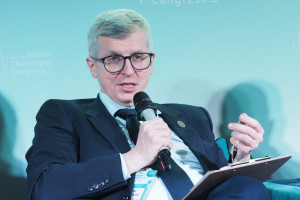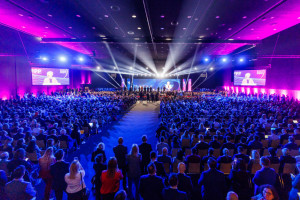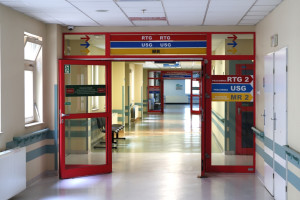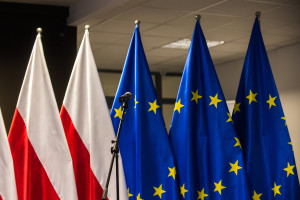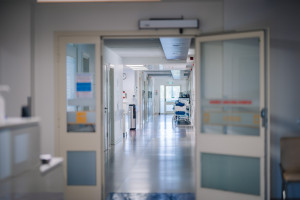Innovative and effective. A breakthrough in cancer treatment in Poland

- Personalization of treatment and its extension are now also possible in radiotherapy thanks to adaptive radiotherapy.
- Poland has a chance to become a leader in implementing innovations in this field.
- Thanks to the support of artificial intelligence, adaptive radiotherapy allows for the adjustment of the radiation dose in real time to the current location of the tumor and healthy organs
- Such a precisely delivered therapeutic dose allows for more effective and faster targeting of cancer cells, while protecting healthy organs, minimizing complications and improving the quality of life of patients.
- Will Poland take advantage of the opportunity and, among others, funds from the KPO or the Medical Fund for investment in this area? - this was among the topics discussed by experts during the Health Market debate
The radiotherapy used so far is based on highly specialized techniques in which the patient is adapted to the developed treatment plan.
Now, thanks to high-quality imaging tests based on diagnostic magnetic resonance imaging, high-quality cone beam computed tomography in accelerators, and the use of advanced IT solutions and artificial intelligence, the medical team can precisely adjust the radiotherapy process to the current location, shape and size of the tumor, while taking into account healthy organs .
This is how adaptive online radiotherapy works. The dose and target of radiation are selected each time depending on the changing anatomical conditions almost in real time while the patient is on the treatment table.
Radiotherapy is still one of the basic elements of oncological treatment for approximately 50 percent of cancer patients.
In addition to surgery, it offers a chance for complete recovery from cancers such as early prostate cancer, breast cancer, lung cancer, liver and pancreas cancer, and head and neck cancer .
Adaptive radiotherapy is a method of personalized, innovative treatment that is individually tailored to each patient and at the same time spares healthy organs.
The innovation is based on maximum precision of treatment while administering effective doses of radiation.
This innovative approach is gaining recognition as a breakthrough technology in oncology, offering significant clinical, technological and economic benefits.
It also has the potential to revolutionize oncology in Poland, especially since our country can now use funds from the National Reconstruction Plan (KPO) and the Medical Fund for this purpose.
This is an unprecedented opportunity to modernize the Polish healthcare system, including the oncology sector. Following the example of Germany or the Netherlands, Poland can become a leader in innovation and benefit from world-class solutions for oncology patients.
The experts discussed the challenges and opportunities related to the implementation of adaptive radiotherapy using dynamic magnetic resonance imaging techniques and high-quality computed tomography in Poland, where to look for funds to finance the investment and whether Poland can become a leader in the use of adaptive radiotherapy during the debate " Innovations in radiotherapy " organized by the editorial office of Rynek Zdrowia.
- We have made enormous progress in medicine, especially in imaging (...). Therefore, adaptive radiotherapy devices very precisely depict both the places where we should deliver a dose of radiation, but also the places that we should protect, the so-called risk organs. And this is our biggest priority now, because we are able to deliver a large dose to the tumor area, while our diligence and attention are particularly drawn to critical organs, those that we would like to strongly protect - said Dr. Tomasz Filipowski , head of the Radiotherapy Department at the Maria Skłodowska-Curie Oncology Center in Białystok.
Dr. hab. n. med. Maciej Harat , coordinator of the Clinical Department of Radiotherapy at the Oncology Center named after prof. Franciszek Łukaszczyk in Bydgoszcz, referring to the question of whether we need increasingly precise tools for oncological therapy, indicated three reasons.
- It is primarily the fact that patients are now living longer, using modern treatment methods and are paying more and more attention to the quality of life after treatment. Hence, it is necessary to make every effort to ensure that our treatment method is as friendly to patients as possible and generates the fewest complications. The second reason is related to the fact that immunotherapeutic treatment methods are being introduced, which we combine with radiotherapy, and the dose that we administer to healthy tissues is not without significance. We strive to intensify the dose in the target and minimize it in the margin. This correlates beautifully with immunotherapy. It improves treatment results - explained Dr. Harat.
The third reason – he said – is the development of technology and imaging capabilities, which allows for precise targeting of radiotherapy.
Dr. Tomasz Filipowski explained that in adaptive radiotherapy "we adapt the treatment plan to the everyday clinical situation."
- A patient who comes for radiotherapy first has a tomography or magnetic resonance imaging (depending on the type of accelerator) and we adjust our treatment plan, i.e. our radiation doses that will be delivered to the patient in the tumor area, to the current anatomical situation - he described.
- This is the difference and this is the advantage for the patient and, of course, for the doctor, that we know perfectly well where the dose was delivered on a given day - he added.
Adaptive vs. Traditional RadiotherapyAs experts emphasized, adaptive radiotherapy is a modern treatment method that is only just coming into use, but its potential is enormous.
- Previous studies have shown that we can reduce the irradiated areas (...), so patients tolerate the treatment better - says Dr. Harat . He cited studies from a few years ago from Stanford on the treatment of prostate cancer using adaptive radiotherapy. They showed that this method can reduce urinary complications by 40 percent, and rectal complications by as much as 60 percent.
- What do we see using adaptive radiotherapy? How the position of these organs changes, how can we limit the dose in the anterior wall of the rectum or protect the urethra, which is extremely important - explained the expert.
As he argues, it is already possible to assess that this therapy is more beneficial for the patient . It is also personalized, because doctors constantly adjust the treatment to the current anatomical picture and changes in the position of the organs.
Dr. Robert Kwiatkowski, M.D., head of the Radiotherapy Department at the Katowice Oncology Center, also noted that the reduction of irradiated healthy tissues will automatically translate into a reduction in the number of complications .
He added that adaptive radiotherapy is also a chance to treat those patients who have not been eligible for radiotherapy so far and were referred for palliative treatment, e.g. elderly patients with bladder cancer, suffering from multiple diseases. The new method also allows for irradiation of changes in soft tissues in the bladder or rectum.
In turn, Dr. Tomasz Filipowski drew attention to increasing opportunities for younger patients.
- They are at the beginning of their career path and limiting complications in the irradiated area is particularly important for them, because these are people who often do not stop working. They are in the middle of work and come to us for treatment, and they still have the prospect of further work - he emphasized, drawing attention to the economic aspect of adaptive radiotherapy.
The use of adaptive radiotherapy also translates into up to half the number of sessions.
Dr. Robert Kwiatkowski explained that verification of the tumor position, and thus reduction of the margin, allows for increasing fractional doses and thus shortening the treatment time.
Introducing innovations and staff qualificationsThe introduction of innovative treatment methods often requires improving the qualifications of staff in order to fully utilize the possibilities of the new technique.
Dr. Maciej Harat admitted that adaptive radiotherapy is a labor-intensive method and certainly requires increased competence of electroradiologists. As he says, a specialist physician, a medical physics specialist, and an electroradiologist are necessary in the team.
- But we see that we can learn all of this. All of this is largely supported by both artificial intelligence and very user-friendly software (…). For now, we are learning this treatment method, so it definitely requires more commitment, as well as more stringent criteria for qualifying patients - said Dr. Harat.
At the same time, he reminded that most facilities have many years of experience, and adaptive therapy is a kind of evolution, not revolution, so the experience so far allows for faster implementation of new methods.
Dr. Robert Kwiatkowski said that the staff has advanced algorithms for therapy planning, which allow for reducing the hours previously devoted to drawing.
- Today, most things are automatic, so we can make corrections to plans and then we will use the recovered time on the machine - he added. However, hospitals are struggling with challenges in the field of oncological treatment infrastructure.
- Unfortunately, in many places there are shortages when it comes to diagnostic imaging, because it was once organized by companies that were established on the basis of hospitals. This is certainly not an optimal solution. Ultimately, it would be better if this infrastructure belonged entirely to the hospital - assessed Dr. Kwiatkowski, arguing that it would facilitate and speed up diagnostics, e.g. in emergency situations when metastases are suspected.
According to him, broader training of staff in oncological radiotherapy is also necessary, but this subject is not taught at most universities, and future doctors do not learn during their medical studies what radiotherapy looks like or what the current achievements in this field are.
- If doctors don't know this, how can patients know - said Dr. Kwiatkowski, emphasizing that about 50 percent of cancer patients require oncological radiotherapy at some stage, which can be combined with surgery, systemic treatment and immunotherapy.
- We need to train in this, show it, encourage it, attract our younger colleagues to want to pursue this specialization - he added.
Dr. Maciej Harat admitted that the work of the Bydgoszcz center where he works has been improved by the installation of magnetic resonance imaging within the Radiotherapy Department. This has resulted in most patients, including all those with changes in the central nervous system and most with changes in the abdominal cavity, having access to magnetic resonance imaging, which has shortened the treatment time.
- After all, we are still fighting for the treatment time, we are still talking about it. The e-DILO card is coming, so we have to think about what changes in infrastructure should be introduced so that this treatment can be faster. So there are specific infrastructural things that improve this, increase this accessibility, which we have to think about, we have to talk about, because precise treatment without magnetic resonance is often very difficult - said Dr. Harat.
The second issue is suitably qualified staff , because there is a shortage of medical physicists , among others. The expert gave the example of Kazimierz Wielki University in Bydgoszcz, where the course was introduced and physicists are trained.
According to him, we should also consider whether to adapt the law to the innovations that have changed radiotherapy and whether, for example, radiotherapy planning should still be the domain of medical physics specialists only, when they are in short supply "and we have untapped potential on the market, for example in electroradiologists". Many European countries, such as Norway, Great Britain and the Netherlands, have gone down this path.
Another aspect is introducing doctors to the possibilities of innovative radiotherapy methods already at the study stage, among others thanks to scientific clubs or participation as medical assistants.
- They can come after hours, after their classes and see how fascinating this specialization is and how dynamically it is developing - indicated Dr. Harat. It is also necessary to increase the competences of electroradiologists to implement changes now.
Dr. Tomasz Filipowski also noted that oncology, including radiotherapy, should be an element of the education of future medics, so that they can "really learn how this field of medicine, which is radiotherapy, is developing dynamically."
- They would certainly be more willing to take on the challenge of specializing in this field - he said.
As for the challenges faced by the existing radiotherapy centres in Poland that have equipment for adaptive radiotherapy, taking into account the hardware requirements, software, staff training and research capabilities, they could merge into national consortia, following the example of international consortia, in order to exchange knowledge and experience.
The patient's perspective, or the myths that still circulate and the lack of access to innovative radiotherapy- We are currently at the beginning of this path, these devices are only just being launched, we are just starting, so it is very important to share our observations, our knowledge and also use international knowledge - emphasized Dr. Filipowski.
The patient's voice could not be missing in the discussion.
Piotr Fonrobert, member of the Board of the Polish Coalition of Oncological Patients, president of the Association for Assistance to GIST Patients, assessed that "the patient is the weakest link in this system", mainly because many myths and a negative image of radiotherapy still persist among patients as a very dangerous method that can result in burns.
- The patient is not armed with the knowledge he should have about radiotherapy in general, let alone adaptive radiotherapy - noted Fonrobert.
As he said, this concept is confused with preparations for regular radiotherapy, and patients do not know that they can use a method that is more effective and is aimed at bypassing healthy tissue.
He also noted that knowledge about innovative treatment methods, including adaptive radiotherapy, is not provided by doctors, and it is difficult to find information on this subject on the Internet.
- When it comes to adaptive radiotherapy, these materials do not really exist - he said.
That is why we welcome any initiative such as the debate on innovative radiotherapy, because it allows information about adaptive radiotherapy to reach a wider group of patients.
An important role is also played by patient associations and organizations, which should disseminate information about each new effective treatment method. - There is a lot to do - summed up Piotr Fonrobert.
Poland's chance to be a leader in EuropeWhen implementing adaptive radiotherapy, Poland can benefit from the best practices from Germany and the Netherlands, which have already successfully implemented this method.
Prof. Esther Troost , Head of the Department of Radiotherapy and Radiation Oncology at the Karl Gustaf Carus University Hospital in Dresden, highlighted the groundbreaking potential of adaptive radiotherapy.
Three years ago, her department implemented a linear accelerator with integrated magnetic resonance imaging, which allows for modification of the patient's treatment plan. Such adaptive radiotherapy limits radiation margins and, thanks to higher doses, reduces the number of radiotherapy sessions, which is important for a patient who travels, for example, 300 km to the hospital.
- Patients who know that the treatment will be completed within a few sessions are more willing to undergo treatment and are more satisfied with it - she emphasized and added that more and more patients are professionally active during treatment. Individualized treatment, which is shorter and has fewer complications, is therefore a huge advantage for patients. It allows them to return to work faster or not even interrupt it, i.e. they can remain productive in economic life and work for the development of the country, whether it is Poland, Germany or the Netherlands.
As Prof. Esther Troost said, this innovative therapy requires dedicated staff and provides work for high-class specialists, oncologists and technicians. In this context, specialists not only operate the equipment, but also actively participate in adapting the therapy to the individual needs of patients.
According to Prof. Esther Troost, we should join forces in Europe, create large networks of cooperation to move this field and science forward. Poland has a chance to take a leading role in the implementation of adaptive radiotherapy alongside Germany, Belgium and the Netherlands.
The expert encouraged Poland to invest in this innovative treatment method, if possible, both through government funding and other potential sources.
KPO as an opportunity to invest in innovations in oncologyTo finance investments in oncology, including the implementation of innovative radiotherapy, Poland may obtain some funds from the National Reconstruction Plan .
Senator Agnieszka Gorgoń-Komor , who founded the Parliamentary Team for the Reconstruction Fund, emphasizes that this is a great opportunity, and innovations and new technologies are like a pendolino.
As she pointed out, innovations are implemented in large centers that are prepared for this, among other things in terms of staff, which sometimes raises objections from smaller centers, and the National Oncology Network should be the answer to this problem. Thanks to the cooperation of the centers, the patient will be properly directed and will know where to go for treatment.
Senator Gorgoń-Komor added that the development of technology should be accompanied by the education of medical staff in this area and their informing patients about new treatment options. - Poland can be a leader if it focuses on innovation and on educating the medical staff that we lack - she assessed.
According to the senator, the challenge is also the stereotypes and myths that have grown around radiotherapy and education is needed in this area. As she pointed out, personalized medicine is moving in this direction to increase the effectiveness of therapy while minimizing its side effects.
- I believe that as Poland we have a huge knowledge potential, we have fantastic experts. And we, as decision-makers, must listen to these experts, (…) in terms of implementing the procedures that are already used in the world - said senator Agnieszka Gorgoń-Komor.
In the opinion of the parliamentarian, we should also focus on educating medical staff and, already in the core curricula at university, convince them to use new technologies, and at the same time encourage them to choose those specializations where innovations can be used for increasingly effective treatment with minimal complications.
Senator Agnieszka Gorgoń-Komor reminded that "good medicine costs and quality costs", but the opportunity is the funds from the Reconstruction Fund, which should be spent in accordance with the health needs of Polish women and men, and with an aging society, Poles still die from heart diseases, and oncological diseases come second.
In the case of investments in innovations in medicine, public-private partnerships can also provide support, because technologies are constantly developing.
- Business support, but transparent, clear and specific, should be support for medicine if we want to be at the forefront and provide good, high-quality services - she said.
She added that there are many countries that benefit from such partnerships with good results. However, good legislation is needed to make the processes transparent. She pointed out that investments in health and innovation are particularly important in the context of demography, because "with a low birth rate, we have to take care of every person who is with us in Poland from the moment they are born."
The Investment Assessment Department of the Ministry of Health, in response to questions sent after the debate, recalled that under the National Oncology Strategy and the task "Re-equipping radiotherapy facilities - purchase of radiotherapy planning systems, re-equipping planning stations (including the purchase of new versions) and re-equipping accelerators", the purchase of equipment was co-financed for a total amount of PLN 157 million and the selected implementers (10 entities for 2023 and 14 for 2024) could apply for the following equipment:
- radiotherapy planning systems,
- retrofitting of the planning station (including purchase of new versions),
- retrofitting of accelerators (new functionalities enabling the implementation of new treatment techniques and precise monitoring of the irradiation area).
"Equipping accelerators with advanced radiation verification and imaging systems with the ability to manage patient positioning ( adaptive radiotherapy ) was aimed at ensuring greater safety of therapy for oncological patients (reduced toxicity) and shortening the convalescence period," emphasizes the Ministry of Health.
As the Investment Assessment Department adds - "the implementation of procedures based on new functionalities, especially in combination with tools using artificial intelligence to analyze anatomy, enabling automatic correction of the plan (changes in the patient's positioning on the treatment table, by matching the new anatomical location to the original treatment plan or corrections of planned dose distributions) accelerates, increases the precision and effectiveness of adaptive radiotherapy".
The Department reminded that, additionally, investment D1.1.1 is being implemented as part of the KPO, the aim of which is, among others, to improve access to and quality of oncological care through the development and modernisation of the infrastructure of hospitals (belonging to the National Oncological Network) and cooperative centres operating within their structure.
"Within the framework of the above-mentioned investment, it is possible to purchase or modernize medical devices and products necessary for the implementation of services in the field of oncological diagnostics and treatment. The tasks planned to be implemented in the projects may go beyond the scope of the assigned SOLO level, so it is possible to support radiotherapy in this scope within the framework of the above-mentioned investment," the ministry explained.
At the end of the debate, all participants admitted that adaptive radiotherapy is not only the future, but already the present in cancer treatment in Poland .
It brings significant clinical, technological, systemic and economic benefits and, above all, it is an opportunity to improve the results of cancer treatment in Poland and the quality of life of patients.
They emphasized that we can only hope that as a country we will seize this opportunity to become a leader in innovation and offer world-class solutions to cancer patients.
Copyrighted material - reprint rules are specified in the regulations .
rynekzdrowia


